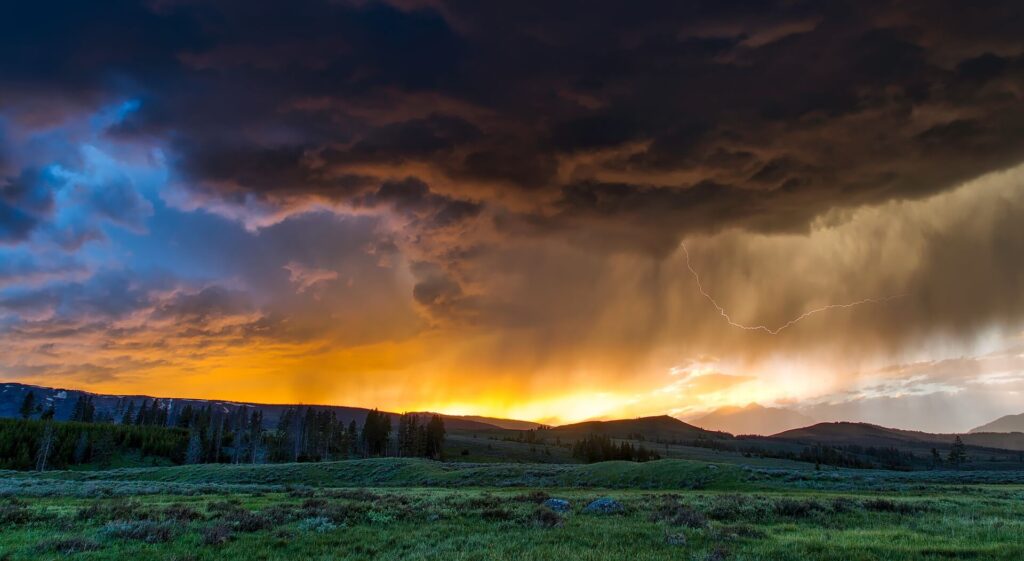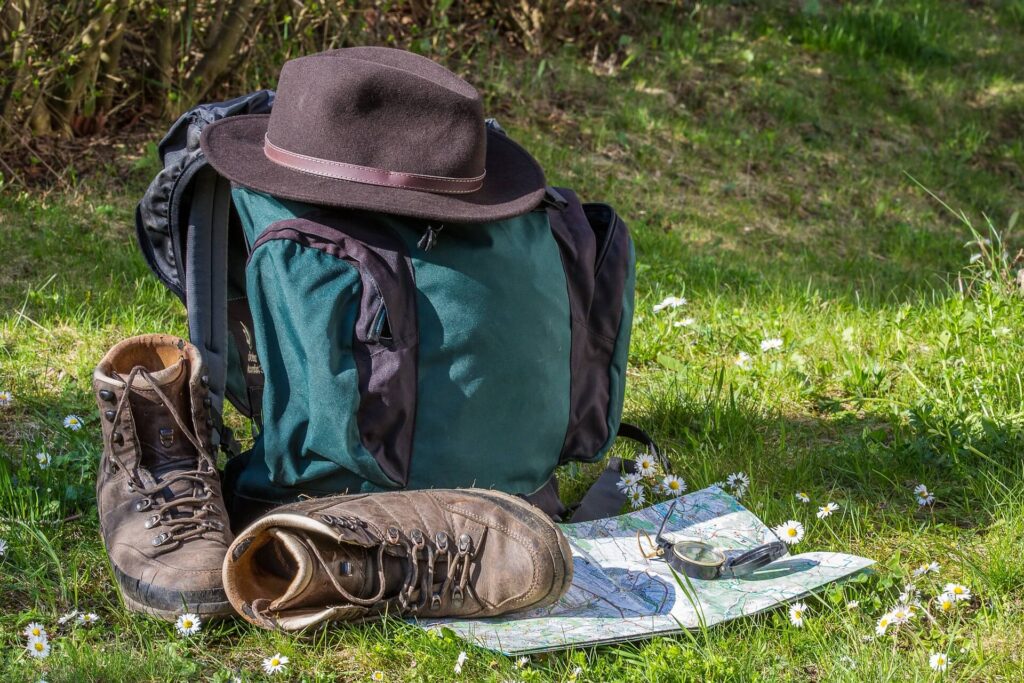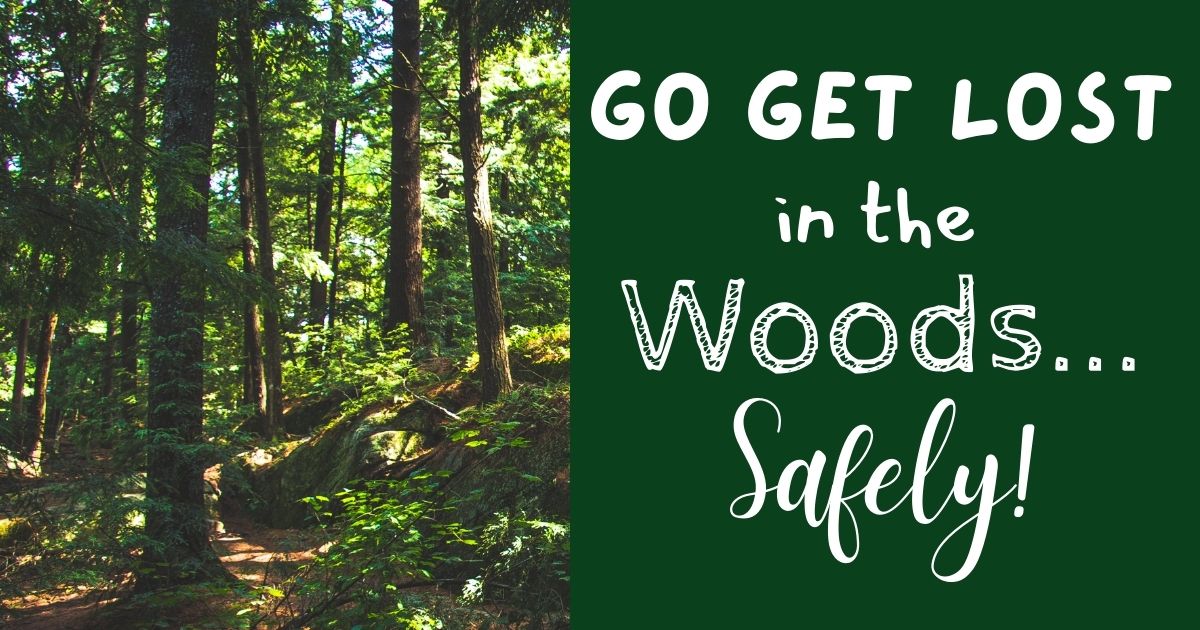Adventure time!
And, you’re off to become one with nature! You’ve got your boots, your trusty walking stick, your sense of adventure, and the wide-open trail…everything you need? Yeah…actually, that’s definitely NOT everything you need.
Don’t get me wrong – you need each of those things. A great place to start, those things! And you’re already outside, so go ahead and…
…take a deep breath. That’s right! Grab yourself a gulp of that delicious fresh air!!
There ya go. Exhilarating!
Now.
Turn around.
Go back to your dang house, you adventurer, you!
Seriously. You need to pack some essentials that may literally save your life.
Don’t let the unexpected and ever-changing nature of…well, Nature…ruin your adventure! You’re frolicking off into the woods to connect with nature. Prepare for meeting it!
Set yourself up for success!
Expect the best! Be prepared for the worst.
It doesn’t matter how long you will be gone.
I don’t care.
Don’t tell me it’s “just for a couple of hours!”
Will you be out of ear-shot of other people? People who aren’t adventuring with you?
Will you be out of eye-shot from your vehicle?
Mm-hmm. Thought so. You need to prepare.
You’re absolutely right! Probably, nothing bad will happen.
But…what if it does?
Your plan is NOT always what happens.
And a lot of things that could go wrong are entirely preventable.
Stop, think, and prepare for the worst.
The best part is this:
The worst probably WON’T happen!
You’ll most likely get out there with all your stuff, and you might need one or two items you brought.
That’s a good day!
But let me speak to you from experience.
If you find yourself in a position that requires your emergency equipment or provisions – even once in your whole life – you will never EVER forget them (or intentionally leave them behind) again. And you won’t ever complain about carrying them.

Ask the scary questions.
I have been in outdoor emergency situations.
They can be terrifying, even with the required emergency equipment.
What if you slip and sprain an ankle?
What if it gets dark, and you can’t safely get back to your car tonight?
What if it snows? (Yes, even in July – elevation is crazy.)
What if you meet a bear?
What if you don’t have the things you need in these situations?
I’m not going to beat around the bush here.
The wilderness can be a dangerous place. Safety is no joke.
You can die out there.
So, ask yourself the difficult questions.
The scary, “What if…?” questions.
And then, figure out how you could prepare for those situations, and do the best you can.
Don’t panic!!
Don’t get too carried away imagining the worst.
Could the worst happen? Yes. Will it? No one knows that! You can’t predict the future.
Besides, the scariest thing you can imagine probably wouldn’t go the way you think it might.
Meeting a bear, for instance.
I’ve met with bears. They were scared of me, too, and ran away.
Could they kill me? Yes.
Did I bring bear spray? Yes!
Did I need to use it? Nope.
Also, they were beautiful, and I have a richer life for having seen them.
They mostly eat berries and moths, anyway.
And honey. Well, entire beehives, really.
Know who else loves honey? Winnie the Pooh!
Aww, Winnie the Pooh is a good bear!
And Paddington? The very best!
See? Dangerous things don’t always have to be scary.
Take another deep breath, and look at things as calmly as you can.
Ask the hard questions, but don’t let your mind wander too far.
You don’t want to miss out on your adventure because you scared yourself away!
Prepare for what you can.
Quit worrying about the things you can’t control.
You can’t prepare for an earthquake. (OMG, what if there’s an earthquake??)
You CAN prepare for a severe cut on your hand from stabilizing yourself on a sharp rock…because the earth was quaking!?
Focus.
A cut. You can prepare for a cut!
You can prepare for (preventing!) blisters on your feet.
You can prepare for a hole in your pants.
You can prepare for rain.
Take another deep breath. Calm down. You’re still alive, and you’re going to prepare to stay that way!
Turn around, go back to your house, and get the things you need.
You’ll breathe easier. You’ll have more fun. And if you need the emergency items you bring, you’ll have them!
(You probably won’t need them, stop freaking out!)
Consider the risks.

Wildlife
Stay alert
Don’t wear headphones in bear-filled parks in Alaska, for instance.
Seriously, I used to live in Anchorage, and there were literally bears and moose (also highly dangerous) in the park across the street from my house.
That is one of the best parks in the world. I loved it. It is NOT the place for headphones.
But what if you feel like jammin’?
Share the beats!
Make noise
Go ahead – blast that music (or podcasts – yes, those are jam-worthy, too!) for all the animals to hear! The noise will alert wildlife to your presence, and that helps deter critters.
Don’t want music? Get a bear bell, or just talk to yourself.
Who cares if you look crazy? You’ll look crazy and alive.
Animals are scared of you, too. You are a visitor in their home. Surprising them is not good.
But, if they know you’re coming, they can make the informed decision to leave you the heck alone.
Or maybe they will ask you to tea! Stranger things have (probably) happened.
Really, though, you’re less likely to be viewed as a threat if you don’t scare the animals.
Sharing the day with wildlife can be a fantastic experience. Don’t be afraid to walk among the dragons!…umm…I mean birds…
There are precautions you can take to keep yourself safe. Research the wildlife that lives in your area to determine how you can prepare for a walk in the woods.
A good rule of thumb, though? Use your brain, and stay alert.
Trust your gut, and don’t go against your better judgment. I can’t stress this enough.
If you feel unsafe, leave. Period. Live to walk another day!
Other humans
The big bad wolf is not the only villain you might meet in the woods.
But honestly, most people you will meet in the great outdoors went out there for the same reasons you did – to go on an adventure away from their daily lives (and, possibly, other humans).
They are probably friendly. But respect any distance asked for.
Again – if you find yourself in a situation that makes you feel unsafe, leave. There are plenty of places to camp.

Weather
What you wear adventuring is a personal preference. You’ll want an extra change of clothes, just in case – and you’ll want to prepare for weather changes.
Weather can be highly unpredictable – even from a studio equipped with radar and all sorts of mapping technology.
When you get out in the field, you won’t be able to watch the weather channel.
You have to watch the weather itself.
Do you see clouds in the distance? Watch them. Are they coming in your direction? Yes? Begin looking for shelter. They will probably arrive faster than you expect.
Be prepared to hunker down and wait out a thunderstorm. Or a winter storm.
Don’t leave yourself exposed in an open field. Lightning is dangerous.
If you have to make your own shelter, guess what? You have that equipment with you!
Sometimes, it’s just a light rain, and you can throw on your rain jacket & pack cover and keep walking. But hey! You have your rain gear, right?
Sometimes it’s raining, and then it’s sleeting, and suddenly – it’s snowing! No problem! You have a coat, a winter hat, and gloves – right here!
Controlling your body temperature in the outdoors is very important.
Staying warm in the cold is all about conserving what body heat you have and staying dry. Take it seriously.
Staying cool in the heat – which is just as serious – is about balancing body heat, sun exposure, and walking conditions. Wearing sunscreen, a hat to keep the sun off of your face, and a bandana (which you can wet down in a stream) to keep the sun off your neck is a good start.
You’ll drink more water when it’s hot outside, so plan for that.
Weather conditions can change in the blink of an eye. Know where you are going – the elevations you’ll be trekking across, the weather forecast (helpful, but not perfect), and the current conditions you’ll be walking into.
Is there snow on the summit of the mountain you’re hiking? You might want an extra layer of clothes in your pack. And your coat.
If you know you’ll be pushing through undergrowth, you’ll probably want long pants. Well-maintained trails, on the other hand, might be the perfect place to break out your hiking shorts.
If you find that you aren’t well-prepared for the weather you encounter, head back to the car.
Sometimes, getting back to your vehicle can take much longer than you think – so start back as soon as you begin questioning your safety. There is no shame in regrouping in a safe location and heading back out when the weather has improved!

Bring the essentials.
Okay. We’ve established you need more than your sense of adventure.
What the heck do you need??
And what if your friend is exploring with you?
Good questions.
Every member of your adventuring party needs their own emergency equipment.
It’s best if each party member carries their own emergency kit. You could get separated. But, in the very least, you should pack enough emergency vittles to go ‘round.
As for what to bring – you want to be strategic about what you carry. Stuff weighs a lot.
If you are planning a backpacking trip, there are even more things you will need. You’ll be staying in the wilderness for several days, after all! However, that’s outside of the scope of this post.
Luckily, the basics are the basics.
So, for now, let’s just focus on those!
Maps
Do NOT leave home without at least one map of where you will be…and know how to read them!
Knowing where you are is essential for safely getting back home when you planned.
You’ll want a compass to help with navigation, too. It doesn’t have to be fancy – it just needs to point north.
You want to get lost in the adventure, not literally lost in the woods!
What type of map do you need?
You will probably want a topographic map! (Roads are marked on them, too.)
More specifically, you’ll likely want the 7.5-minute quadrangle maps for the areas you will be trekking through. These tend to have trails marked on them, contour lines indicating elevation, roads, and natural landmarks.
You can easily find topographic maps using the USGS Map Locator. They are instantly downloadable – for free – and you can order hard copies straight to your door.
Ranger stations also carry topographic maps, and sometimes, specific trail maps.
If trail maps are available for your trail, grab one of those too!
One more thing: if you’re able to invest in a handheld GPS (Global Positioning System) device, I highly recommend it. Especially if you’re going to be out in the sticks, miles from civilization (which can be quite lovely).
You want to remain aware of where you are on the map. And you need to be able to do that without a GPS. This is an essential survival skill.
Also, even if you have a GPS, always bring a hard copy of your map.
Your GPS batteries might die. Your replacement batteries might be dead. You might crack the screen on a rock. You might drop your precious GPS in a bottomless lake, only to be found by a creature of the depths…who doesn’t even care where he is. (What a waste!)
Your location is not something to mess around with. Don’t get lost because your equipment plans fail.

Water
You’ll want to bring water with you. Enough for a whole day, at least.
Bring more than you think you will need. It really, really sucks to run out.
How much you need in a day depends on many factors (temperature, physical exertion, etc.) – but somewhere around 2.5-3 liters per person is a great place to start.
Don’t drink water from streams or lakes or the ocean.
The ocean is made of saltwater. That’s not good for drinking.
Streams and lakes and ponds and puddles could contain nasty bacteria, viruses, or parasites that can make you sick. And you’re in the wild. This isn’t the place to be sick!
Nope.
Bring your own water.
And maybe a water pump for filtering more.
Food
You’ll need some snacks, too! Nothin’ like trail mix on the trail!
Actually, my tried-and-true quick-energy food for hiking is…gummy bears.
Cheap, delicious gummy bears!
They deliver quick energy to keep me going between meals.
Bring enough food for the length of time you plan to be out – and then some. You should also bring at least a day’s worth of extra food with you.
Don’t skimp on the calories, either.
You won’t want lettuce if you’re cold and tired and stuck on the side of a mountain in a safety blanket for the night. You’ll need something that will sustain you.
Dried fruit. Fruit cups. Nuts. Beef jerky, tuna packets, energy bars, granola, etc.
You want items that are high in calories, low in weight, and won’t make you drink too much of your water. If possible, you want food that will help hydrate you – like fruit cups or applesauce.
There are lots of great options – and diet is very personal. Just think about what you like to eat, do some research, and try things out on the trail! You’ll develop a list of items that work best for you.
Remember – always pack out what you pack in.
Do NOT leave trash on the side of the mountain.
She will haunt you.
Emergency preparations
Tell your friends!
Check-in with the rangers at the ranger station, if there is one where you are going.
Tell your mom – or your Uncle Harold, or a friend who will be staying home – how long you plan to be gone, where you are going, and when to expect a call from you. Ask them to call for help if they don’t hear from you by the time you set.
Put a copy of your itinerary under the seat (or in the glovebox) in your vehicle.
If an emergency occurs, you might get stuck in the wilderness. If you do, your life may depend on your mom making an emergency phone call to the authorities and passing along the information you left with her.
Be as detailed as you can.
First aid kit
Bring a first aid kit with you. Small cuts and tiny blisters can become a real problem without proper care.
There are also times when disaster strikes, and you need a store of supplies to keep yourself alive.
You can invest in a pre-built first aid kit, or you can build your own. It tends to be cheaper to make your own – and better tailored to precisely what you need.
Here is the list of first aid items that I take with me into the field (I am not sponsored – any links are just links.):
- Personal prescription medications – in case you get stuck in the wilderness
- Alcohol wipes – for cleaning wounds before bandaging
- Band-aids
- Antibiotic ointment
- Anti-itch cream (Ivarest is the absolute best.)
- Ibuprofen – for all your minor anti-inflammatory needs
- Aspirin – in case of heart attack
- Tums
- Benadryl – in case of an unexpected allergic reaction to bee stings, etc.
- Benadryl does not replace epinephrine!! If you need epinephrine, bring it!
- Imodium – diarrhea is dangerous in the wilderness – don’t get dehydrated.
- Cough drops
- Eye drops
- Medical/latex gloves
- Needle & thread – for fixing holes in your pants
- Suture kit – a needle & thread can double for this…but is less efficient
- Bandana – to protect you from sunburn, and/or make a patch for your pants
- Tweezers – for digging out splinters
- Scissors
- Clotting gauze
- Non–stick gauze
- Ace bandage
- Vaseline
- Moleskin – for blister prevention and care
- Aloe vera – get the good stuff, the 99.99% aloe stuff, for minor burns/sunburn
- Swim ear drops – don’t get an ear infection if you fall in the river!

Other emergency items
Along with the other essential items we have discussed bringing, you will need some emergency items outside the realm of a first-aid kit. (Again, I am not sponsored – any links are just links.)
- Phone – your cell; or a satellite phone, if going (particularly, alone) into the backwoods
- External battery pack/charger
- Knife
- Hatchet (Yes, really. Haven’t you read that book? It can save your life.)
- Watch – your phone battery might die
- Headlamp/flashlight
- Extra batteries (in all of the sizes you’re using)
- Bug spray
- Sunscreen
- WetFire starters – they burn hot, even when it’s raining
- Lighter/spark producer/igniter/matches
- Water purification tablets or pump – in case you have to drink from a puddle
- Duct tape – for blister care…& so much more!
- Tenacious tape – this stuff fixes tents, water bladders, and clothing. It’s magical.
- Emergency bivvy/blanket
- Emergency tent
- Paracord/rope
- Whistle – don’t lose your voice yelling for help
- Rain gear – waterproof jacket and pants
- Rain cover for pack – so all your stuff doesn’t get wet
- A change of clothes – in case you fall into the river
- A coat (packable, if possible)
- A winter hat
- A pair of winter gloves
- Extra socks (wool is best – still warm when wet)
This list is an excellent place to start. Think of it as an ever-changing guideline! You’ll need to make modifications based on what type of adventure you are embarking upon. You’ll also make changes based on the experiences you have on the trail.
You started with your sense of adventure, your boots, and your walking stick – don’t forget to bring those, too!
Have fun out there!! That’s what life’s all about!
Go get (safely) lost!
Everything comes down to paying attention.
Listen to yourself. Your body is amazing – it will tell you what it needs. Pay attention! Recognize your limits, and respect them.
There is always room for growth – but do NOT force things! That’s how you get hurt.
Don’t underestimate nature. It can be highly unpredictable.
You are going to experience some things you didn’t expect. Those things don’t have to be as scary as they could be – you’ve come prepared!
And some surprises are beautiful!
Like a swarm of butterflies on the trail.
Or the stillness that comes over the woods when the last rays of sunlight dip below the horizon.
Or coming across a tree that is taller than you can see and bigger around than you can reach.
How many winters has that tree seen? How many baby deer has it watched walk by and then watched grow up? Is it friends with the squirrel in its branches? Has that squirrel’s family lived in that tree for longer than you’ve been alive?
Let your curiosity run wild!
Adventures are worth every single moment you spend preparing.
The wilderness is wonderful.
The earth is beautiful.
Nature is amazing.
And now, you’re ready to go get lost…in wonder!





